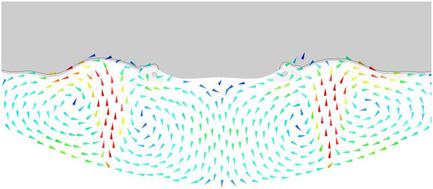当前位置:
X-MOL 学术
›
Steel Res. Int.
›
论文详情
Our official English website, www.x-mol.net, welcomes your
feedback! (Note: you will need to create a separate account there.)
Toward the Bath Flow Interaction of a 250 t Combined Top and Bottom Blowing Converter Based on a Mathematical Modeling
Steel Research International ( IF 1.9 ) Pub Date : 2020-08-31 , DOI: 10.1002/srin.202000334 Xiaobin Zhou 1 , Yong Liu 1 , Peiyuan Ni 2 , Shiheng Peng 1
Steel Research International ( IF 1.9 ) Pub Date : 2020-08-31 , DOI: 10.1002/srin.202000334 Xiaobin Zhou 1 , Yong Liu 1 , Peiyuan Ni 2 , Shiheng Peng 1
Affiliation

|
Herein, the fluid mechanical aspects involving flow interactions between flows formed by the top impinging jet and bottom blowing bubbles in a combined blowing converter bath are focused on. The effects of different operation conditions on the flow field and the kinetic energy of the bath are investigated to examine different roles of the blowing operations with the help of numerical model. It is found that the stirring intensity in the region near the bath wall is decreased even though the flow is more active in the vicinity of the impact cavity when the top lance declines. For the combined blowing converter, the bottom blowing plumes normally dominate the bath flow. However, the bath stirring intensity is increased slightly when the bottom blowing flowrate is higher than a critical value (0.08 Nm3 min−1 t−1). In addition, the results of energy dissipation demonstrate that higher flowrate of bottom blowing causes more intensive interaction between flows formed by the top and the bottom blowing, which, in turn, causes more energy dissipation.
中文翻译:

基于数学建模的250 t上下吹组合转炉的熔池流动相互作用
在此,集中讨论涉及在组合的吹炼转炉中由顶部撞击射流和底部吹泡泡形成的流之间的流相互作用的流体力学方面。研究了不同操作条件对熔池流场和动能的影响,借助数值模型研究了鼓风操作的不同作用。发现当顶部喷枪下降时,即使在冲击腔附近流动更活跃,浴壁附近区域中的搅拌强度也会降低。对于组合吹气转换器,底部吹气羽流通常在熔池流量中占主导地位。但是,当底吹流量高于临界值(0.08 Nm 3 分钟)时,浴搅拌强度会略有增加-1 t -1)。另外,能量耗散的结果表明,底部吹气的较高流速导致顶部吹气和底部吹气形成的流之间的相互作用更强烈,进而导致更多的能量消散。
更新日期:2020-08-31
中文翻译:

基于数学建模的250 t上下吹组合转炉的熔池流动相互作用
在此,集中讨论涉及在组合的吹炼转炉中由顶部撞击射流和底部吹泡泡形成的流之间的流相互作用的流体力学方面。研究了不同操作条件对熔池流场和动能的影响,借助数值模型研究了鼓风操作的不同作用。发现当顶部喷枪下降时,即使在冲击腔附近流动更活跃,浴壁附近区域中的搅拌强度也会降低。对于组合吹气转换器,底部吹气羽流通常在熔池流量中占主导地位。但是,当底吹流量高于临界值(0.08 Nm 3 分钟)时,浴搅拌强度会略有增加-1 t -1)。另外,能量耗散的结果表明,底部吹气的较高流速导致顶部吹气和底部吹气形成的流之间的相互作用更强烈,进而导致更多的能量消散。









































 京公网安备 11010802027423号
京公网安备 11010802027423号